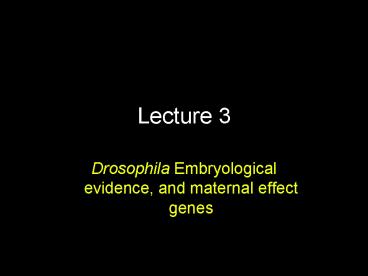Drosophila Embryological evidence, and maternal effect genes - PowerPoint PPT Presentation
1 / 42
Title: Drosophila Embryological evidence, and maternal effect genes
1
Lecture 3
- Drosophila Embryological evidence, and maternal
effect genes
2
Lecture 3
- Aims
- Demonstrate Drosophila has polar centres
- Introduce the maternal effect genes
- Describe the two groups
- Anterior
- Posterior
- Terminal
3
Drosophila embryos have obvious A/P polarity
- Secretes a cuticle, marked with denticle belts,
easy to score segments
4
Five parts Acron, Head, Thorax, Abdomen, and
Telson
5
Score cuticle defects after transplanting
cytoplasm or pricking embryos
- Prick anterior
- lose head and thoracic segments
- Transplant posterior to anterior
- as above
- Prick posterior
- lose abdominal segments and pole cells, but not
telson! - Transplant anterior to posterior
- suppress posterior development and duplicate
thoracic segments
6
- Prick anterior
- lose head and thoracic segments
- Transplant posterior to anterior
- as above
- Prick posterior
- lose abdominal segments and pole cells, but not
telson! - Transplant anterior to posterior
- suppress posterior development and duplicate
thoracic segments
7
Maternal effect mutants
- Genetic screens performed by Nusslein-Volhard and
Wieschaus (1980s) - Female mutants laying defective eggs, as scored
by cuticle pattern - 3 groups
- Anterior
- Posterior
- Terminal
8
Anterior Group
- bicoid - is the key
- exuperentia
- exuperentia-like
- swallow
- staufen
Localisation in the Oocyte
9
bicoid
- allelic series of severity
- transplantation
- rescues in anterior
- duplicates anterior structures in the middle of
embryos - changes in fate map with increased gene dosage
10
Allelic series of severity
11
(No Transcript)
12
Transplantation
13
To the anterior - rescues To the middle -
duplicates
14
Gene dosage and fate map
15
(No Transcript)
16
bicoid cont.....
- mutations mapped to 3rd Xme
- gene cloned by complementation
- Transcription factor and translational inhibitor
- Bicoid is the anterior determinant
- How is the RNA localised?
17
bicoid localisation
- mRNA localised to the anterior pole of late
oocytes and embryos. - Protein translated in the fertilized embryo -
short half-life - Distribution in other anterior mutants altered.
- 3UTR of bicoid message required
18
Localised in oocyte
RNA in situ to bicoid
Antibody to Bicoid
19
(No Transcript)
20
(No Transcript)
21
Other anterior mutants
- Swallow, Staufen - RNA binding proteins
- Exuperentia - binds microtubules, shown by GFP
fusions - Exuperentia-like isolated as binding to bicoid
3-UTR, also binds to Exuperentia
22
Swallow?
Lc8/Dynein
Staufen
Microtubules
BLE1
Exuperentia-like
Exuperentia
23
Refs
Mancebo et al 2001 BSF Binds Specifically to
the bicoid mRNA 3' Untranslated Region and
Contributes to Stabilization of bicoid mRNA.
Molec. Cell. Biol. 21(10) 3462--3471 Cha et
al. 2001 In vivo analysis of Drosophila bicoid
mRNA localization reveals a novel
microtubule-dependent axis specification pathway.
Cell 106(1) 35--46
24
Arn et al. (2003) Dev. Cell 4(1) 41--51
- A biochemical analysis
- purified a protein complex
- identified proteins
- demonstrated involvement in directed
translational control
25
Used Domains IV and V of 3UTR Previously shown
to contain enough info for localisation
Gel Mobility Shift assay with ovary extracts
26
Component Identification
Protein Probe Proteins Westerns
- Modulo
- Swallow
- PABP
- Smooth
- Nod
Native Prep Gel
SDS PAGE
27
Form a complex
Co-immunoppt with anti-Mod
Mod, PABP and Smooth are RNA binding
proteins Nod is a kinesin motor protein And
Swallow is?
28
SwallowGFP Enriched in anterior of Oocyte Is
largely immobile Possibly an anchor for The
bicoid message?
Stephenson (2004) Localization of swallow-Green
Fluorescent Protein in Drosophila oogenesis and
implications for the role of swallow in RNA
localization. Genesis 39 (4) 280-287
29
Posterior group mutants
- 10 mutants first isolated
- no clear determinant - all have similar
phenotypes, missing abdominal segments - Transplantation used to find the determinant
30
All missing abdominal segments If they all
look the same which is the determinant?
31
Take cytoplasm from each mutant and see if can
rescue the other mutants - the one that cant
must be the determinant
32
Nanos is the posterior determinant
- cytoplasm from mutant nurse-cells or oocytes
rescues all but nanos - nanos cytoplasm rescues nothing
- pumilio cytoplasm rescues everything!!!
- determinant is not localised or moved properly
33
RNA in situ to nanos
Antibody to Nanos
34
The key players are Oskar Nanos
35
- Genes regulating oskar mRNA localization
- cappuccino
- mago nashi
- orb (female sterile mutation rather than a
maternal effect) - spire
- staufen
- Genes acting downstream of Oskar
- nanos
- pipsqueak
- pumilio
- tudor
- vasa
36
Oskar is a key player in nanos localisation
- All but nanos and pumilio are also germ plasm
determinants - Stepwise localisation of products
- oskar mRNA has to be translated for Vasa to
localise - oskar translation strictly controlled
- Bruno and Aubergine
37
Double posterior embryos can be produced by
either directing oskar RNA to the anterior pole
by fusing the message to bicoid 3UTR or the use
of BicD mutant mothers
38
Meosin
Par4
oskar translation
Gustavus
39
Meosin
Bruno
Prevents oskar translation
Aubergine
Par4
Augments translation of oskar
40
Key refs
Cha et al . Kinesin I-dependent cortical
exclusion restricts pole plasm to the oocyte
posterior. Nat Cell Biol 2002 Aug4(8)592-8 Van
zo NF, Ephrussi A. Oskar anchoring restricts
pole plasm formation to the posterior of the
Drosophila oocyte. Development 2002
Aug129(15)3705-14 Long and short Osk
41
........and Nanos is?
- translational repressor
- e.g. of bicoid (and hunchback) binds to NREs in
3UTR via Pumilio - Evolutionary homologues
- Dipterans, Xenopus, C.elegans?
- Next time will see it can be completely
dispensable!!!!!
42
Summary Anterior determinant - Bicoid Posterior
determinant - Nanos Previous experiments on
ligatures suggested the existence of
Morphogens Bicoid is a good candidate for such
a molecule































